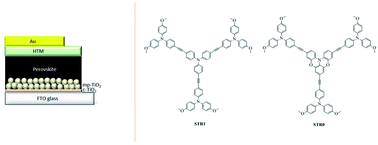Star-shaped triarylamine-based hole-transport materials in perovskite solar cells†
Abstract
Two novel star-shaped triarylamine-based hole transport materials with triphenylamine (STR1), or a partially oxygen-bridged triphenylamine (STR0), as core and para-substituted triphenylamine side arms were synthesized, fully characterized and studied in perovskite solar cells. Their thermal, optical, electrochemical and charge transport properties were examined and compared in the context of their molecular structure. Due to its more planar configuration, STR0 showed a red-shifted absorption in comparison with STR1. STR0 also forms a more stable amorphous glassy state and showed higher glass transition temperature than STR1 and spiro-OMeTAD. These HTMs were tested in perovskite solar cells using a device configuration of FTO/bl-TiO2/mp-TiO2/CH3NH3PbI3/HTM/Au showing a power conversion efficiency of 13.3% for STR0 and 11.5% for STR1. The STR0-based devices showed higher fill factor and better reproducibility than spiro-OMeTAD-based cells. Without dopant additives, solar cells based on STR0 exhibited a good photocurrent density of 16.63 mA cm−2 and the efficiency improved from a starting PCE of 3.9% to 6.6% after two weeks of storage.



 Please wait while we load your content...
Please wait while we load your content...